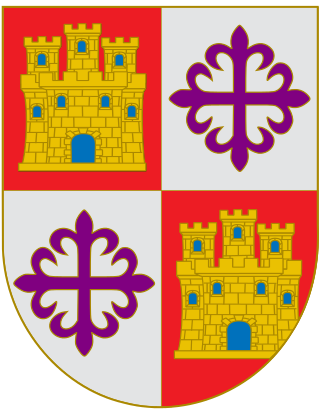
Fernán González was the first autonomous count of Castile. Fernán González was a colourful character of legendary status in Iberia, and founder of the dynasty that would rule a semi-autonomous Castile, laying the foundations for its status as an independent kingdom. In the year 930, Fernán's name appears with the title of count inside the administrative organization of the eastern Kingdom of León.

The Order of Alcántara, also called the Knights of St. Julian, was originally a military order of León, founded in 1166 and confirmed by Pope Alexander III in 1177.

The Diocese of Calahorra and La Calzada-Logroño ) is a Latin diocese of the Catholic Church located in the cities of Calahorra, Santo Domingo de la Calzada, and Logroño in the ecclesiastical province of Pamplona y Tudela in Spain.

The Diocese of Salamanca is a Latin diocese of the Catholic Church located in the city of Salamanca in the ecclesiastical province of Valladolid in Spain.

Manrique Pérez de Lara was a magnate of the Kingdom of Castile and its regent from 1158 until his death. He was a leading figure of the House of Lara and one of the most important counsellors and generals of three successive Castilian monarchs: Alfonso VII (1126–57), Sancho III (1157–58) and Alfonso VIII (1158–1214).
The Treaty of Sahagún ended a state of war between the Castile and León, establishing pacem et ueram amiciciam between their respective monarchs, Sancho III and Ferdinand II, who called themselves boni fratres et boni amici. It was signed at the monastery of Sahagún on 23 May 1158.
Alfonso Fernández el Niño was a Spanish nobleman, the illegitimate son of King Alfonso X of Castile and Elvira Rodríguez de Villada. He was the lord of Molina and Mesa through his marriage to Blanca Alfonso de Molina, daughter of the infante Alfonso of Molina and niece of King Alfonso IX of León.

Fernando Díaz de Haro was a Spanish noble of the House of Haro. He was the second born son of Diego López V de Haro, the Lord of Biscay, and his wife, the infanta Violante de Castilla y Aragón, daughter of Alfonso X of Castile. Fernando became lord of Orduña and Balmaseda in 1322, after the death of his brother, Lope Díaz IV de Haro who died without leaving any descendants.
Violant of Castile was infanta of Castile and Lady of Biscay on her marriage to Diego López V de Haro. She was the daughter of Alfonso X of Castile, and Violant of Aragon.
Afonso of Portugal was a Portuguese noble, son of Afonso of Portugal, Lord of Portalegre and his wife Violante Manuel. He was granted the title of Lord of Leiria. Afonso of Portugal died in 1300 when he was about twelve years of age without having married and without leaving any offspring.
Maria of Portugal was a Portuguese royal, daughter of Infante Afonso of Portugal and his wife Violante Manuel.

Álvaro Núñez de Lara was a Castilian nobleman who played a key role, along with other members of the House of Lara, in the political and military affairs of the Kingdoms of León and Castile around the turn of the 13th century. He was made a count in 1214, served as alférez to King Alfonso VIII of Castile, was the regent during the minority of King Henry I of Castile, and was mayordomo (steward) to King Alfonso IX of León. He opposed Queen Berengaria of Castile and her son King Ferdinand III and supported the King of León during the war between the two countries of 1217–1218. At the end of his life he was a knight of the Order of Santiago, in whose Monastery of Uclés he was buried.

Enrique Enríquez the Younger was a nobleman of Castile, son of Enrique Enríquez the Elder. He was lord of Villalba de los Barros, Nogales, Almendral, La Parra, Begíjar and other towns. He was Adelantado Mayor of the border of Andalusia, chief justice of the King's House, Chief of the forces of the bishopric and Kingdom of Jaén, Mayor of Seville and Knight of the Band.

Enrique Enríquez the Elder was a nobleman of Castile, natural son of the Infante Henry of Castile. He was Lord of La Puebla de los Infantes. His son, Enrique Enríquez the Younger, had a distinguished career serving kings Alfonso XI of Castile and Peter of Castile.
Bermudo Ovéquiz was a member of the highest ranks of the nobility of Asturias, León, and Galicia who lived in the 11th century.
Alfonso Enríquez, Count of Noreña and of Gijón and lord of several places, was the eldest son of King Henry II of Castile and Elvira Íñiguez born before the king's marriage. As one of the most powerful feudal lords in Asturias, where he owned many properties, he attempted to declare the independence of this region from his brother King John I and then from his nephew, King Henry III of Castile. He and his Portuguese wife, Isabel of Portugal, a natural daughter of King Ferdinand I, are the ancestors of the Noronha lineage in Portugal.
Rodrigo Muñoz was a Galician count in the Kingdom of León, best known for his death at the Battle of Sagrajas fighting for Alfonso VI of León.

Álvaro de Zúñiga y Guzmán was a Castilian nobleman, member of the influential House of Zúñiga, of Navarrese origin. He was one of the most powerful men in Castile, as evidenced by his numerous titles and the offices he held, and was involved in much of the kingdom's most important political and military events, notably in the various conflicts between the nobility and the candidates for succession to the throne that would culminate in the War of the Castilian Succession and that would only calm down with the final recognition of the Catholic Monarchs, whom he initially opposed but eventually supported.










